Research
I am interested in the study of organismal motion in a broad sense, with emphasis on flight performance in unsteady and multi-phase flows. I am also curious on the role of electrical forces on animal-animal and animal-plant interactions at small scales
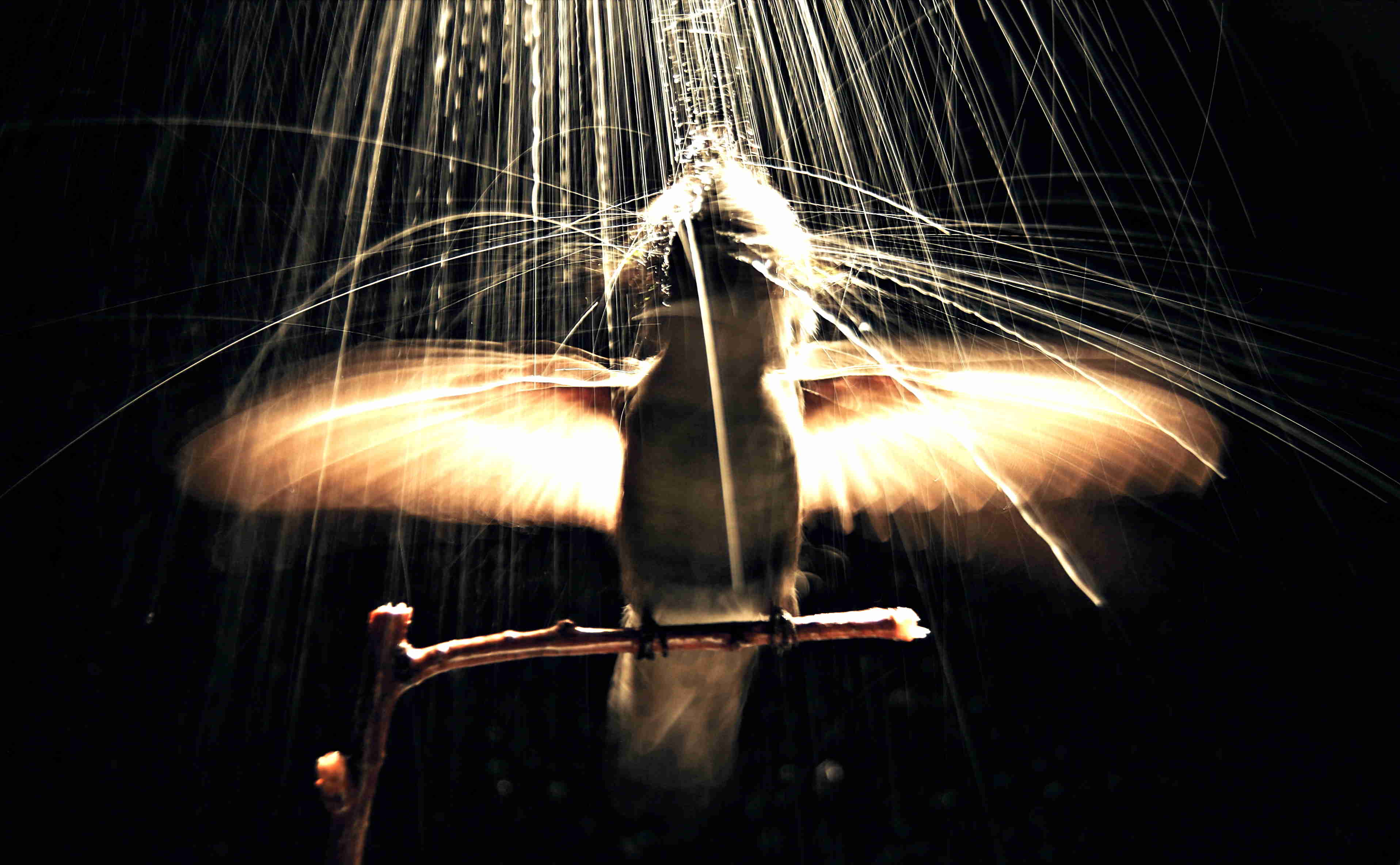 Earth’s nectar from the sky / two phase flows. Precipitation is a common atmospheric phenomena with the capacity to disrupt most animal activities, and even, in extreme events, jeopardizes survival. I have special interest on the effects of two-phase flows (e. g. rain) on the flight performance of small animals. My first studies indicate that light-to-moderate precipitation barely affects hummingbirds, but in heavy rain these birds presented marked kinematic and postural changes, as well as increased mechanical costs. Besides, hummingbirds can remove the water attached to their plumage using violent body shakes even in mid-air.
Earth’s nectar from the sky / two phase flows. Precipitation is a common atmospheric phenomena with the capacity to disrupt most animal activities, and even, in extreme events, jeopardizes survival. I have special interest on the effects of two-phase flows (e. g. rain) on the flight performance of small animals. My first studies indicate that light-to-moderate precipitation barely affects hummingbirds, but in heavy rain these birds presented marked kinematic and postural changes, as well as increased mechanical costs. Besides, hummingbirds can remove the water attached to their plumage using violent body shakes even in mid-air.
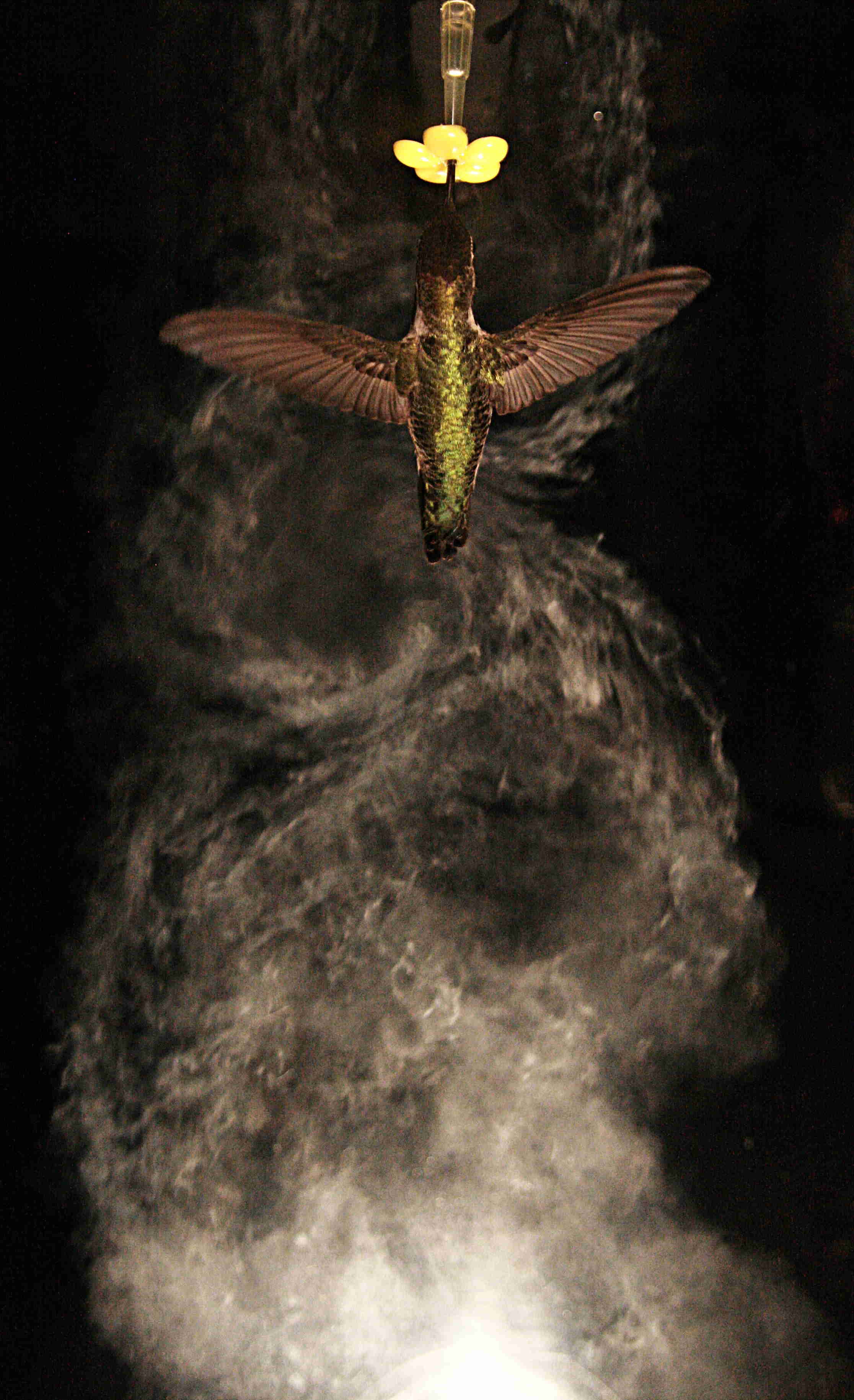 Storm winds / non-steady flows. Fluids in nature generally run wild. Vortex shedding, ripples and turbulence are common architectural components of flows. I study the effects of unsteady flows on locomotor performance and stability, as well as the relationships between the perturbation’s size, distance, frequency, and intensity in comparison with the animal’s size. Recently we studied the energetics and kinematics of hummingbirds and moths flying into varied Von Kármán vortex streets. I am also curious about the effects of ripples and bubbles on the locomotor performance of water-waking animals.
Storm winds / non-steady flows. Fluids in nature generally run wild. Vortex shedding, ripples and turbulence are common architectural components of flows. I study the effects of unsteady flows on locomotor performance and stability, as well as the relationships between the perturbation’s size, distance, frequency, and intensity in comparison with the animal’s size. Recently we studied the energetics and kinematics of hummingbirds and moths flying into varied Von Kármán vortex streets. I am also curious about the effects of ripples and bubbles on the locomotor performance of water-waking animals.
 Unconventional locomotion / maneuverability. Rapid transitional and rotational abilities, as well as energy-saving mechanisms, are essential for an animal’s survival and reproductive success. I focused on the study of vertical burst flights of small animal fliers. For example, I found that hummingbirds during vertical flights maintain extreme wing kinematics and exert maximal power and even can keep ascending with their wings completely folded. On the other hand, it is well known that aircrafts flying close to the ground reduce power output for a given thrust. Our experiments of hummingbirds hovering in ground effect indicate energy-savings up to 25%.
Unconventional locomotion / maneuverability. Rapid transitional and rotational abilities, as well as energy-saving mechanisms, are essential for an animal’s survival and reproductive success. I focused on the study of vertical burst flights of small animal fliers. For example, I found that hummingbirds during vertical flights maintain extreme wing kinematics and exert maximal power and even can keep ascending with their wings completely folded. On the other hand, it is well known that aircrafts flying close to the ground reduce power output for a given thrust. Our experiments of hummingbirds hovering in ground effect indicate energy-savings up to 25%.
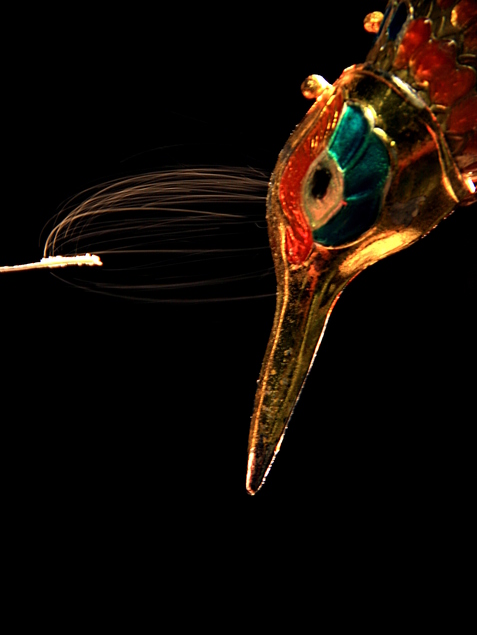 Electrifying mysteries / electrostatic effects. At small scales electrostatic forces reign over other forces humans are subjected to, like gravity. I am interested in the study of electrostatic effects produced on small animals. I discovered that spiderwebs are specialized electrical traps that can capture charged insects more easily. Furthermore, we recently found that flying hummingbirds have enough electrical charge during dry days to produce electrical attraction of pollen grains and also floral stamen, which can enhance plant pollination.
Electrifying mysteries / electrostatic effects. At small scales electrostatic forces reign over other forces humans are subjected to, like gravity. I am interested in the study of electrostatic effects produced on small animals. I discovered that spiderwebs are specialized electrical traps that can capture charged insects more easily. Furthermore, we recently found that flying hummingbirds have enough electrical charge during dry days to produce electrical attraction of pollen grains and also floral stamen, which can enhance plant pollination.
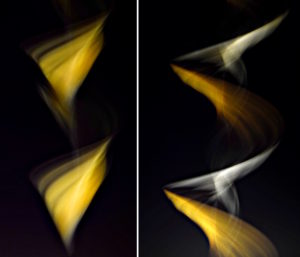 Natural autogyros / Autorotation of wings.
Natural autogyros / Autorotation of wings.
Some plant seeds, of maples or pines, can fly through the air while falling down in a stable helical motion. Recently, we discovered that isolated animal wings of insects and hummingbirds are capable of free autorotation achieving similar performance than helicopter seeds. Curiously, even whole (dead) insects with intact wings can autorotate. Our results offer novel insights into animal wing aerodynamics and illustrate an impressive functional convergence between animal and plant wings.
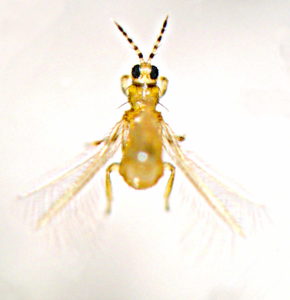 Moving on water/ Meniscus ascent. For many terrestrial insects, water bodies are mortal traps because they are unable to escape the slippery slope produced by the meniscus. We discovered that thrips, which are millimeter-size flying insects, can effectively ascend it by arching their bodies and performing spin maneuvers to gain a favorable climbing position. We also demonstrated that thrips climbing performance vary inversely with fluid viscosity.
Moving on water/ Meniscus ascent. For many terrestrial insects, water bodies are mortal traps because they are unable to escape the slippery slope produced by the meniscus. We discovered that thrips, which are millimeter-size flying insects, can effectively ascend it by arching their bodies and performing spin maneuvers to gain a favorable climbing position. We also demonstrated that thrips climbing performance vary inversely with fluid viscosity.
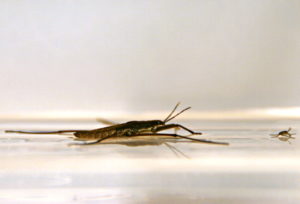 Rowing ripples/ Unsteady locomotion. Water surfaces in nature are commonly plagued with dynamic irregularities, like waves and air bubbles. We discovered that water striders experience a degraded locomotory performance while moving over perturbed waters(i.e. on wavy and bubbly surfaces), being age-class dependent. First instar-class could not deal with the bubbly surface environment, at the point to be launched at high speed during a bubble bursting. We suggest that perturbed water surfaces may play an important role on age-class habitat partition, predation and energy costs on surface dwelling insects.
Rowing ripples/ Unsteady locomotion. Water surfaces in nature are commonly plagued with dynamic irregularities, like waves and air bubbles. We discovered that water striders experience a degraded locomotory performance while moving over perturbed waters(i.e. on wavy and bubbly surfaces), being age-class dependent. First instar-class could not deal with the bubbly surface environment, at the point to be launched at high speed during a bubble bursting. We suggest that perturbed water surfaces may play an important role on age-class habitat partition, predation and energy costs on surface dwelling insects.
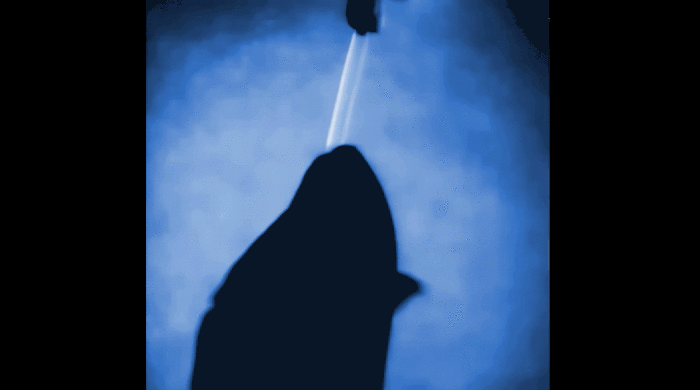 UltraRapid suction/ Induced cavitation. We recently discovered that Black Ghost Knifefish can generate cavitation bubbles using a powerful, sudden and close-range suction. As far as we know, this is the first time that cavitation is demonstrated and quantified in vertebrates. This discovery can challenge our current view on suction-feeding mechanism in fish, as well as in other aquatic organisms. Moreover, we suggested that flow acceleration is an important variable to understand animals interacting with liquid flows.
UltraRapid suction/ Induced cavitation. We recently discovered that Black Ghost Knifefish can generate cavitation bubbles using a powerful, sudden and close-range suction. As far as we know, this is the first time that cavitation is demonstrated and quantified in vertebrates. This discovery can challenge our current view on suction-feeding mechanism in fish, as well as in other aquatic organisms. Moreover, we suggested that flow acceleration is an important variable to understand animals interacting with liquid flows.
